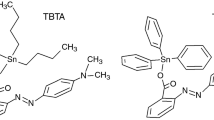Abstract
The alkylation of DNA by antitumor agents such as mechlorethamine hydrochloride (mustargen), thiophosphoramide (TSPA), mitomycin c (MMC), bleomycin-A5 and dacarbazine (DTIC) can be detected with quartz crystal resonators (QCR). In the course of alkylation, the resonator frequency change in polyethylene glycol (PEG)-DNA solutions follows the cross-linking of DNA and the cleavage of the sugarphosphate backbone of DNA. It is at least partly attributed to the viscosity change of the PEG-DNA solution and possibly to some extent to the change of mass adsorbed on the QCR surface due to cross-linking and cleavage. Experimental results are consistent with that expected from theory.
Similar content being viewed by others
Author information
Authors and Affiliations
Additional information
Received: 15 April 1996 / Revised: 3 July 1996 / Accepted: 9 July 1996
Rights and permissions
About this article
Cite this article
Lin, ZH., Shen, GL., Lin, Y. et al. Study of the alkylation behaviors of antitumor agents to DNA using a quartz crystal resonator in PEG-DNA solution. Fresenius J Anal Chem 357, 921–926 (1997). https://doi.org/10.1007/s002160050275
Issue Date:
DOI: https://doi.org/10.1007/s002160050275



